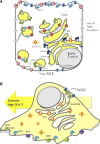Cellular calcium dynamics in lactation and breast cancer: from physiology to pathology
- PMID: 24225884
- PMCID: PMC3948975
- DOI: 10.1152/ajpcell.00330.2013
Cellular calcium dynamics in lactation and breast cancer: from physiology to pathology
Abstract
Breast cancer is the second leading cause of cancer mortality in women, estimated at nearly 40,000 deaths and more than 230,000 new cases diagnosed in the U.S. this year alone. One of the defining characteristics of breast cancer is the radiographic presence of microcalcifications. These palpable mineral precipitates are commonly found in the breast after formation of a tumor. Since free Ca(2+) plays a crucial role as a second messenger inside cells, we hypothesize that these chelated precipitates may be a result of dysregulated Ca(2+) secretion associated with tumorigenesis. Transient and sustained elevations of intracellular Ca(2+) regulate cell proliferation, apoptosis and cell migration, and offer numerous therapeutic possibilities in controlling tumor growth and metastasis. During lactation, a developmentally determined program of gene expression controls the massive transcellular mobilization of Ca(2+) from the blood into milk by the coordinated action of calcium transporters, including pumps, channels, sensors and buffers, in a functional module that we term CALTRANS. Here we assess the evidence implicating genes that regulate free and buffered Ca(2+) in normal breast epithelium and cancer cells and discuss mechanisms that are likely to contribute to the pathological characteristics of breast cancer.
Keywords: SPCA2; breast cancer; lactation; mammary epithelium; secretory pathway.
Figures



References
-
- Ardeshirpour L, Dann P, Pollak M, Wysolmerski J, VanHouten J. The calcium-sensing receptor regulates PTHrP production and calcium transport in the lactating mammary gland. Bone 38: 787–793, 2006 - PubMed
-
- Asanuma H, Nakai H, Takeda M, Shishido S, Tajima E, Kawamura T, Hara H, Morikawa Y. Renal cell carcinoma in children: experience at a single institution in Japan. J Urol 162: 1402–1405, 1999 - PubMed
-
- Aung CS, Ye W, Plowman G, Peters AA, Monteith GR, Roberts-Thomson SJ. Plasma membrane calcium ATPase 4 and the remodeling of calcium homeostasis in human colon cancer cells. Carcinogenesis 30: 1962–1969, 2009 - PubMed
Publication types
MeSH terms
Substances
Grants and funding
LinkOut - more resources
Full Text Sources
Other Literature Sources
Medical
Miscellaneous

